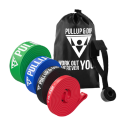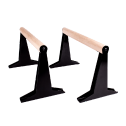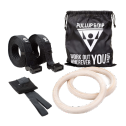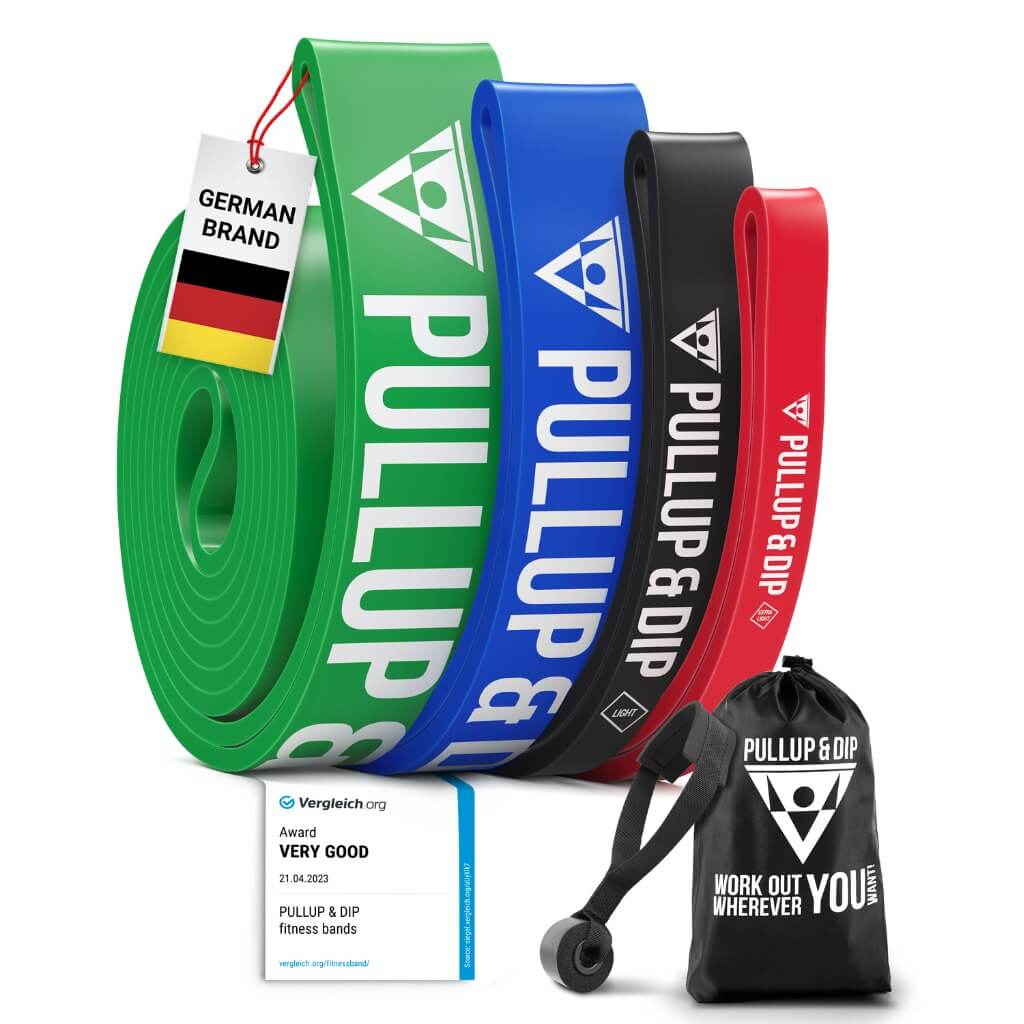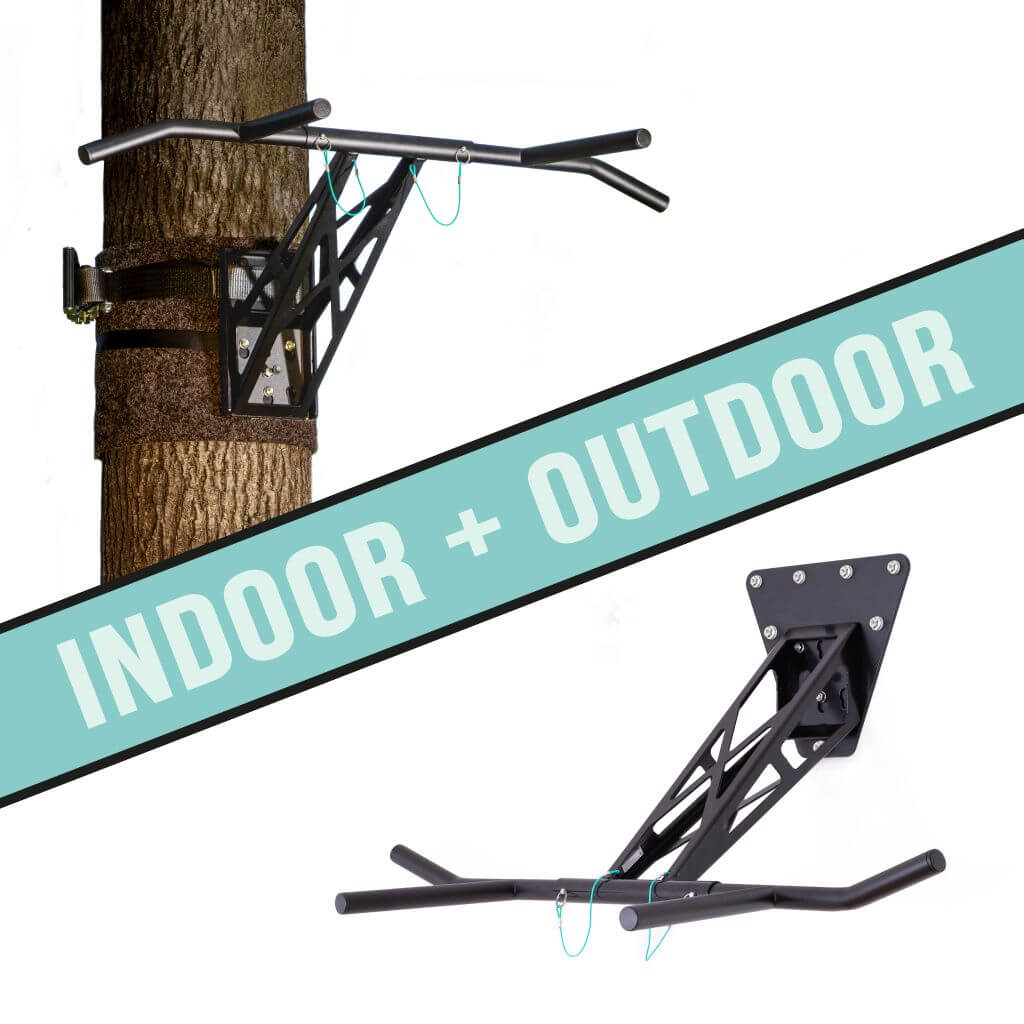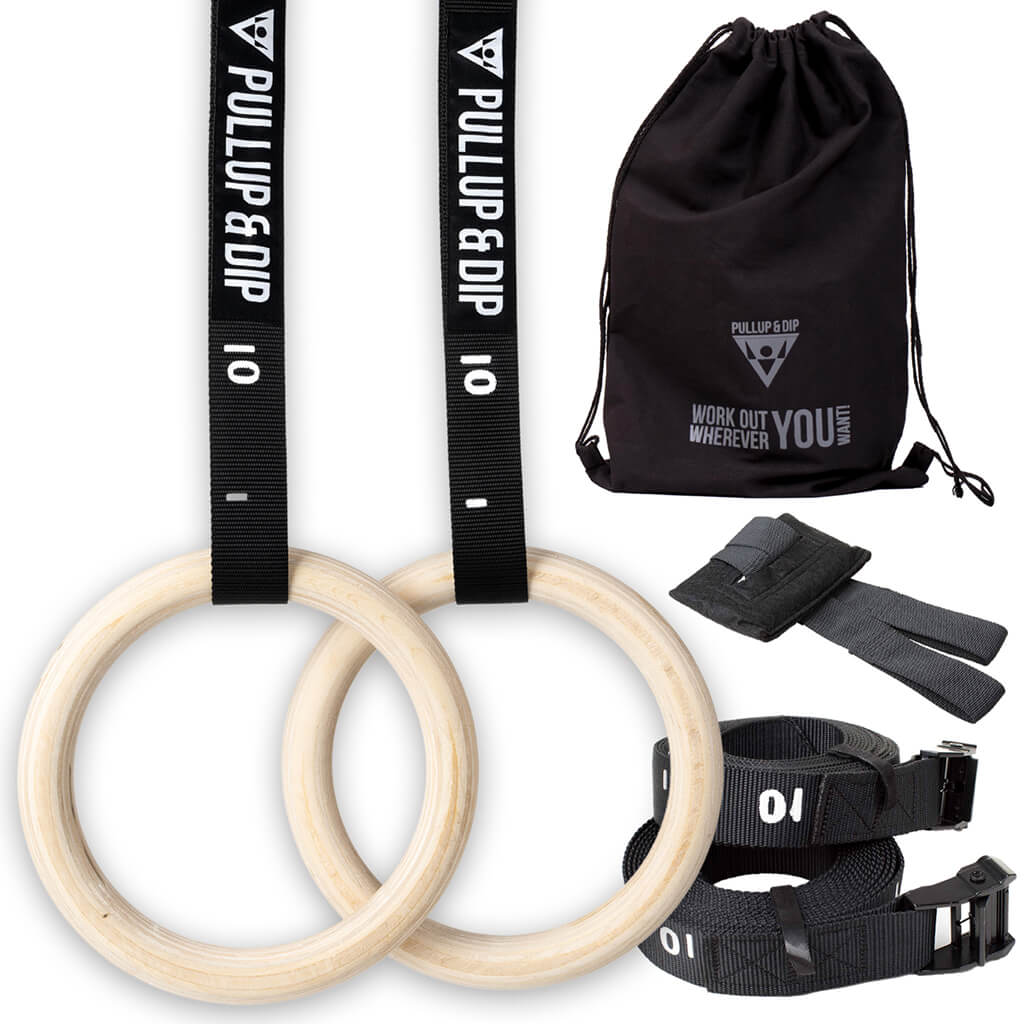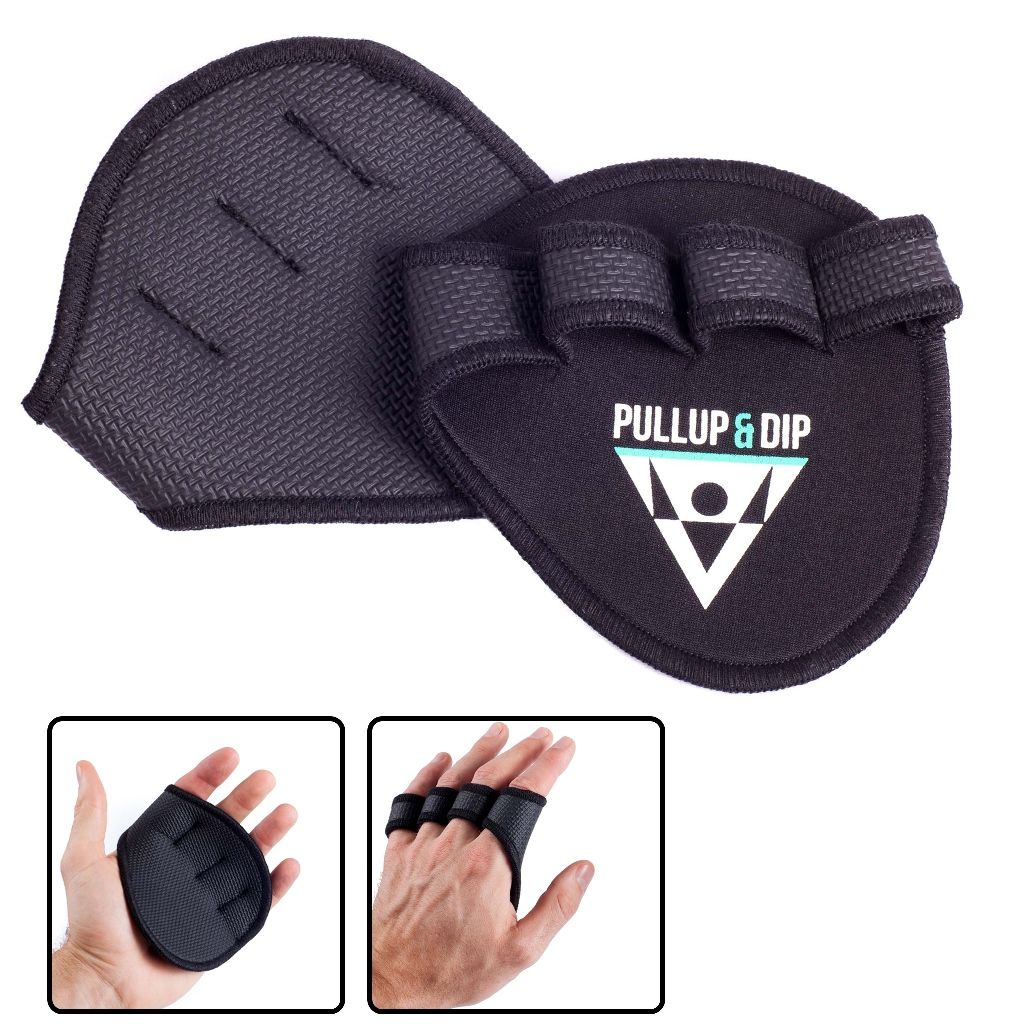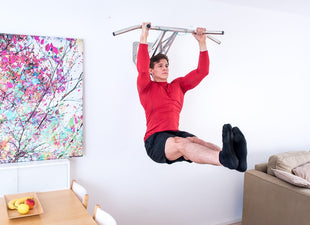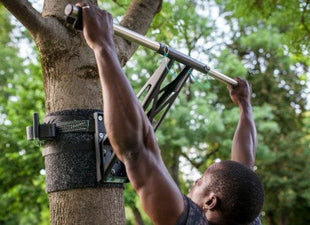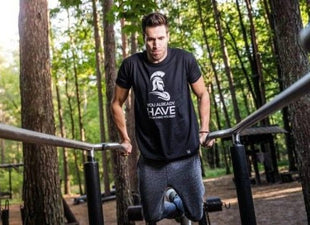Everyone knows them – some hate them, others love them, but everyone benefits from them: Pull-ups. In this article, you will learn all the important facts: What do pull-ups actually do, what are their benefits, how do you do them correctly? We will also explain what equipment you need for pull-ups. Once you are equipped with the best possible knowledge, you can get started immediately!
Pull-ups – what are the benefits?

If one physical exercise were voted a classic, this would be it: Pull-ups. There is hardly any other exercise that is as effective and important as the pull-up. But why? First of all, a pull-up is a so-called compound or complex exercise. This includes exercises that work a relatively large part of your body simultaneously. In the case of pull-ups, it is mostly the upper body that is worked. Depending on the version, whether you use the overhand or underhand grip or if you do narrow or broad pull-ups, the exercise focuses on either your upper back, or your entire back – but, no matter which version you choose, your back and arms will get an intensive workout. As a result, pull-ups do not only help to build muscles – they also prevent back pain, and last but not least they make your back very attractive (the famous V-back). Through regular training and a constantly increase in muscle stimulation, you will be able to develop a strong, healthy back relatively quickly with pull-ups.
Generally, pull-ups offer a lot of advantages: First of all, they save you time and money, because you can do them almost anywhere and your own body is all you need. Whether on the playground, on a branch or with an outdoor pull-up bar, see above, you can get rigged up for a pull-up workout very quickly, wherever you are. If necessary, you can do them on any door, but more about that later. Secondly, if done correctly, they are very healthy for your back – especially for people who sit a lot, or for those office workers among us, pull-ups can trigger beneficial stimulation of the muscles, which (after some practice) can also be fun. And last, but not least – due to their high degree of complexity – they are very effective for building muscle, therefore they must be included in any bodyweight workout plan.
Which muscles are worked the most when doing pull-ups?

There are many different variations of pull-ups. Depending on the technique used, different muscle groups are worked. The two most important differences in pull-ups are the type of grip and the width of the grip. There are two possible grips you can use, the "underhand grip" and the "overhand grip". The "underhand grip", i.e. with your fingertips pointing towards you whilst doing the pull-ups, focuses more on the arms, whereas the "overhand grip", i.e. with the backs of your hands towards you, focuses more on the lats. If your grip is the width of your shoulders, primarily your entire back gets a workout, whereas a wider grip focuses more on the width of the upper back (the V-shape).
You can also set different stimuli for your muscles by changing the number of repetitions: if you want to work at muscle building, you shouldn't exceed 8-12 repetitions (with additional weight if needed), and those who want to train for strength endurance should not exceed 12 – 20 pull-ups. If you want to work on high-speed strength, you shouldn't do more than 20 pull-ups at a time. In principle, pull-ups are a highly versatile exercise, which means that you can always adapt the way you do them to suit your goals. They are suitable for beginners, who can also use pull-up bands for as long as they need them, to practice the correct execution and coordination. Advanced users can do more difficult pull-up variants (for example with additional lateral movements) or they can work with additional weights, in order to increase the stimulation of the muscles

To our pull-up bands!
[product="P-00095"]
How to do pull-ups correctly!

Whether you use the underhand or overhand grip, or a narrow or wide grip, there are important basic rules for every pull-up, which you must follow to make sure that you execute them correctly. Most important: Slow movements! The lowering motion, in particular, should always be performed slowly, so that the duration of the muscle load is high enough. If you are not yet able to do pull-ups yet, to begin with, you can start simply: jump up and grasp the pull-up bars, and try to lower yourself slowly. Over time, you'll find that it becomes easier and easier for you to do your first proper pull-up. As far as the height is concerned, you should always get your nose at least to the height of the bars, so that it counts as a proper pull-up. Ideally, however, your chin should reach the height of the bar. You should also ensure that your arms are fully extended after at the lowest point. Many sportsmen and women keep them slightly bent, in order to avoid the difficult, but more effective stimulus.
And last, but not least: Be careful not to swing! Bend your legs, and cross them if you like, but be careful not to swing back and forth. In pull-ups, the movement should always be straight up and down. If you follow all these tips, you'll find you'll make fast progress and your back will be sufficiently strengthened!
What pull-up options are there for at home?
Do you want to rush off immediately to do a power pull-up session? Hang on a minute! Let us first show you the best options for doing your pull-up workout at home, no mess, no fuss. These are the best options:
1. Pullup & Dip bar for indoors and outdoors

For those who would like to switch from working out indoors to working out outdoors, this Pullup & Dip bar is the perfect solution. It can easily be fastened to a tree with tension straps, or to a wall with screws, and you can take it anywhere. You will be well equipped and there will be nothing standing in the way of your workout.
2. Pull-up bars for the wall

Pull-up bars for the wall are the classical variant: You can simply mount them on a load-bearing wall with screws, and your bars will be ready and waiting for you right there in your living room, basement or anywhere else, so that you can work out day and night.
To our pull-up bars for the wall!
[product="P-01009"]
3. Pull-up bars for the door frame

Another alternative is the pull-up bar that can be attached inside a door frame, by means of a twisting mechanism. The disadvantage: if you want to leave it there permanently, you’ll have to duck every time you go through the door to the room in question. The danger also exists that the pull-up bars with the twisting mechanism could slip out of the door frame.
[product="P-01010"]
4. Pull-up bars for the ceiling

Rather than clamping a pull-up bar inside a door frame, you could mount one on the ceiling. This variant offers better stability, but the bar is permanently mounted, so it is not easy to remove it again.
5. Gymnastics rings for the ceiling

The freestyle variant among the pull-up tools: if you like, you could mount gymnastics rings, like these ones, on the ceiling. This option is a bit unusual, but it offers the advantage of training not only your muscle strength, but also your coordination skills. The pull-ups are a bit more difficult, but also a lot of fun!
To our gymnastics rings!
[product="P-00080"]
6. Pull-up stations

A pull-up station like this one, requires a bit more space, but it offers all kinds of conveniences that are not available from other equipment. Thanks to the multi-grip construction, you can do a lot of different exercises with this device, and if it is properly assembled, the stability is also guaranteed. What’s more, you do not need a load-bearing wall for it, and you will not get into trouble with your landlord either.
Pull-ups without pull-up bars: it goes like this
If you do not want to buy any equipment, there are still various options for your workout. Because the risk of injury and the effort required are relatively high, these options are not really recommended, but if you are determined to give it a try, you can consider the following possibilities:
1. Carpet bar
Everyone knows what carpet bars are. They are those rectangular things, out in the garden, where grandma always beats the heck out of her old long-pile carpet. As long as it will support your weight, a carpet bar is perfectly suitable for pull-ups. The most important thing is to ensure that no danger of injury exists, and that you are absolutely certain that it will support your weight.
2. Doorframe without bars
Those who know how to do it, can also do pull-ups on a door frame. But, to get it right, you need incredible strength in your fingers, so you might have to work on that first. Therefore, this version is probably best for climbers.
3. Door
Of course, one alternative to the door frame is the door itself: Drape a towel over an open door and grasp the top of door through the towel. Now, you can pull yourself up and lower yourself again. Make sure that you do not injure yourself on the rabbet of the door (the overlap ridge on the upper edge) and, to be on the safe side, put a shoe inside the door frame to make sure that the door doesn’t close while you’re working out. And most importantly: Do NOT do it on a glass door!
4. Branches

The purest outdoor pull-up variation is offered by mother nature herself: simply hang from the branch of one of the trees in the garden, and do your pull-ups like that! But check the thickness of the branch first: if it is too thin, it might not be able to carry your weight, and if it is too thick, you might not be able to grasp it properly. It might take a little time before you find the perfect branch, but don’t worry! It’s there somewhere, just waiting for you!
5. Balcony overhang
If you have a balcony at home, you can also try it on the balcony overhang. But, of course, it is very important that it is not too high above the ground – a 3rd floor balcony, for example, would not be a good idea, because of the risk of serious injury in the case of a fall. This is not really the most pleasant option, but it does work if you have no other possibilities!
6. Children’s swing

Children’s swings often work superbly as workout equipment, thanks to the stable crossbars. Simply hang on the bar and off you go! Once you get the hang of it, you can have a little swing in between, whilst resting between your sets!
For the highly motivated: Pull-up variations for even more muscle stimulation

Of course, with any kind of pull-up device, you can do more than just pulling yourself up and letting yourself down again. Good pull-up bars not only provide the perfect basis for cleanly executed pull-ups! They can also be used for a whole range of other exercises. Muscle-ups, for example, are a very advanced form of pull-ups where, after pulling your head up over the bar in a regular pull-up, you push your body upwards vigorously, so that you are in an upright position, from which you push yourself upwards, away from the bar. Muscle-ups are basically a mixture between pull-ups and dips, which makes them a highly functional but also very difficult combination. You can also do dips on the pull-up bars, independently of your pull-ups. These are referred to as "Straight Bar Dips". Whatever your approach to the exercise, one thing is certain: practice makes perfect!
But not only your upper body benefits from a diversified workout with the pull-up bars – your lower body will also profit. Whilst hanging straight down on the bar, you can simply do leg lifts for your lower abdominal muscles, or you can swing your toes up to the bar, over your head (this is called "toes to bar"). Alternatively, with your body in an L-position, you can twist your outstretched legs to the left and right – this is a very effective exercise, especially for your torso and lateral abdominal muscles.
Summary of pull-ups

Pull-ups are the ultimate power exercise and should not be missing from any workout plan, whether at the gym or for bodyweight training. Because of their complexity, they promote good health, build muscle and enhance your appearance. Due to the many different variations, the level of difficulty can easily be adjusted, which makes them ideal for both beginners and advanced athletes. Investing in a pull-up bar is always a good idea, because it not only minimises your workout time and the risk of injury! It also provides you with an additional training device with which you can do both abdominal and leg exercises. The pull-up bars is a genuine all-rounder!
Are you looking for a suitable pull-up bar for indoors & outdoors to also train your biceps? We at Pullup & Dip offer you various high quality and unique pull-up bars. Go check them out now!

Recommendes articles:
Gymnastic rings - 10 very effective exercises
 Other Equipment
Other Equipment
 Gripping Aids
Gripping Aids
 Bandages
Bandages
 Tapes
Tapes
